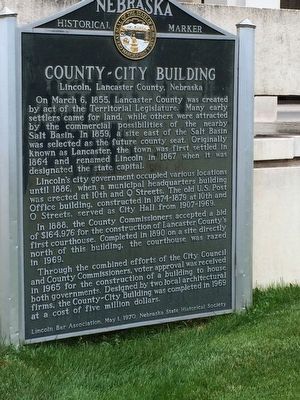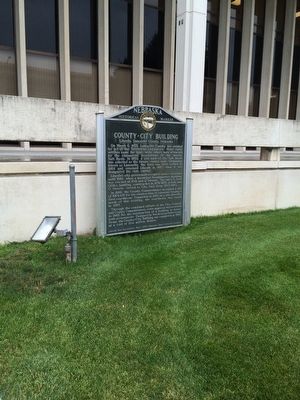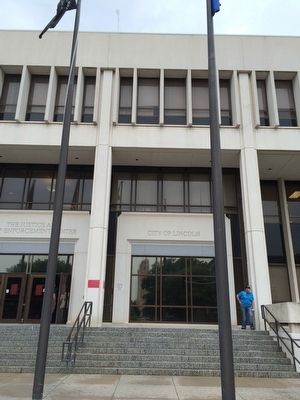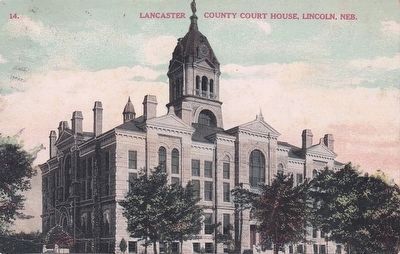County - City Building
Lincoln, Lancaster County, Nebraska
Lincoln's city government occupied various locations until 1886, when a municipal headquarters building was erected at 10th and Q Streets. The old U.S. Post Office building, constructed in 1874-1879 at 10th and O Streets, served as City Hall from 1907-1969. In 1888, the County Commissioners accepted a bid of $164,976 for the construction of Lancaster County's first courthouse. Completed in 1890 on a site directly north of this building, the courthouse was razed in 1969.
Through the combined efforts of the City Council and County Commissioners, voter approval was received in 1965 for the construction of a building to house both governments. Designed by two local architectural firms, the County-City Building was completed in 1969 at a cost of five million dollars.
Erected 1970 by Lincoln Bar Association Nebraska State Historical Society. (Marker Number 105.)
Topics and series. This historical marker is listed in this topic list: Government & Politics. In addition, it is included in the Nebraska State Historical Society series list. A significant historical date for this entry is March 6, 1855.
Location. 40° 48.491′ N, 96° 42.436′ W. Marker is in Lincoln, Nebraska, in Lancaster County. It is in Downtown. Marker is on S. 10th Street. Touch for map. Marker is in this post office area: Lincoln NE 68508, United States of America. Touch for directions.
Other nearby markers. At least 8 other markers are within walking distance of this marker. Mari Sandoz in Lincoln (approx. 0.2 miles away); Chief Standing Bear (approx. 0.3 miles away); a different marker also named Chief Standing Bear (approx. 0.3 miles away); The Nebraska Governor's Residence (approx. 0.4 miles away); Artesian Well Fountain (approx. 0.4 miles away); U.S. Post Office and Courthouse (Old City Hall) (approx. 0.4 miles away); The Protecting Hand Sculpture (approx. 0.4 miles away); Salvation Army Building (approx. half a mile away). Touch for a list and map of all markers in Lincoln.
Credits. This page was last revised on February 16, 2023. It was originally submitted on September 12, 2015, by Pat Filippone of Stockton, California. This page has been viewed 427 times since then and 39 times this year. Photos: 1, 2, 3. submitted on September 12, 2015, by Pat Filippone of Stockton, California. 4. submitted on September 14, 2015. • Bill Pfingsten was the editor who published this page.



